Plant cover, the solution for regenerating agricultural land in Biterrois ?
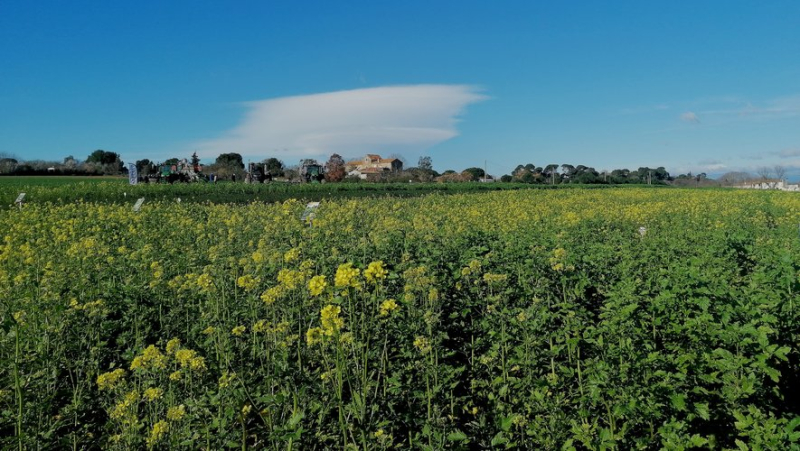
The Chamber of Agriculture has planted different types of plant cover on a plot of Cros-Viguier nurseries, in Béziers. Diane Petitmangin
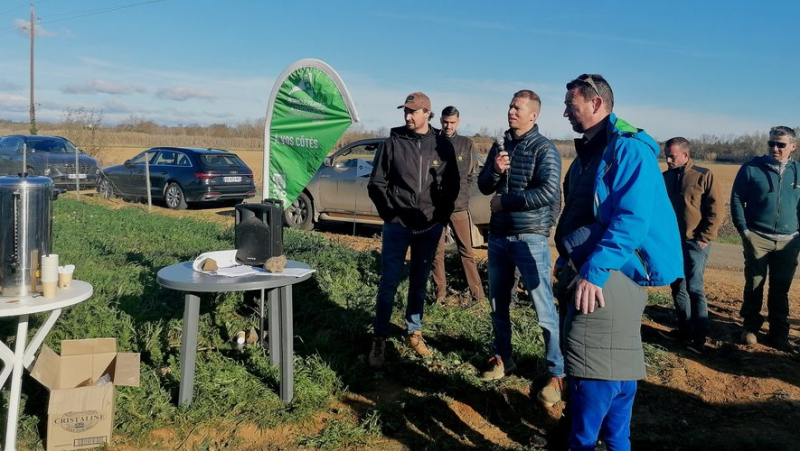
Rémy Kulagowski, manager at the Chamber of Agriculture, microphone in hand, explains what happened during the morning to the farmers present. Diane Petitmangin
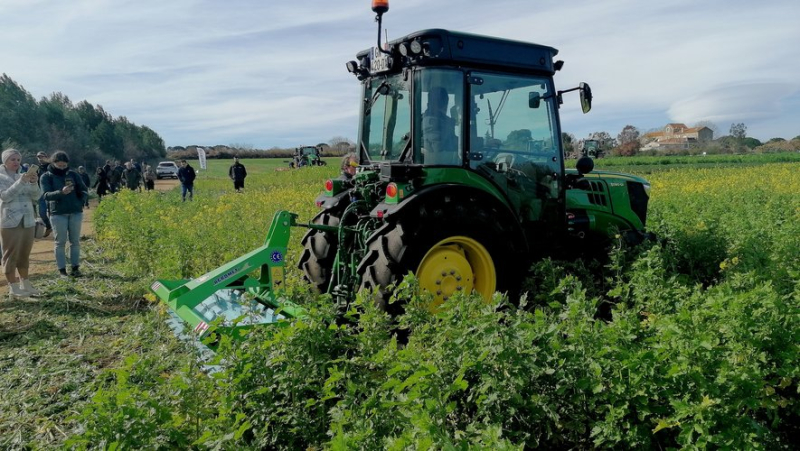
Démonstration du rolofaca, qui permet de coucher les plantations du couvert végétal. Diane Petitmangin
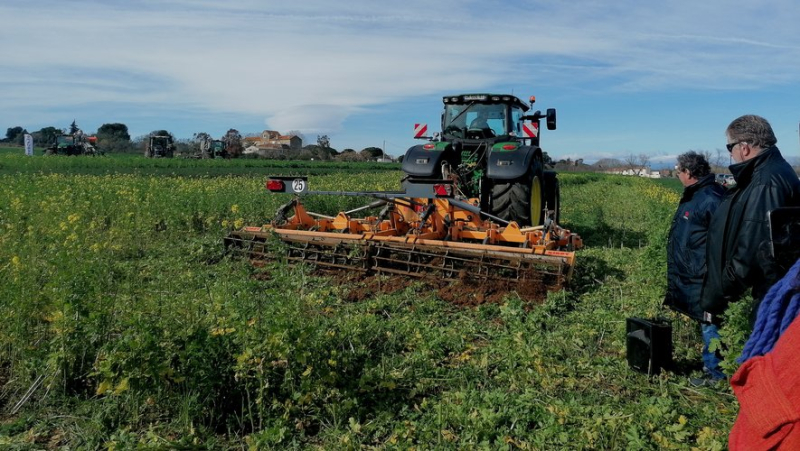
Démonstration d'un engin agricole pour coucher les plantations du couvert végétal. Diane Petitmangin
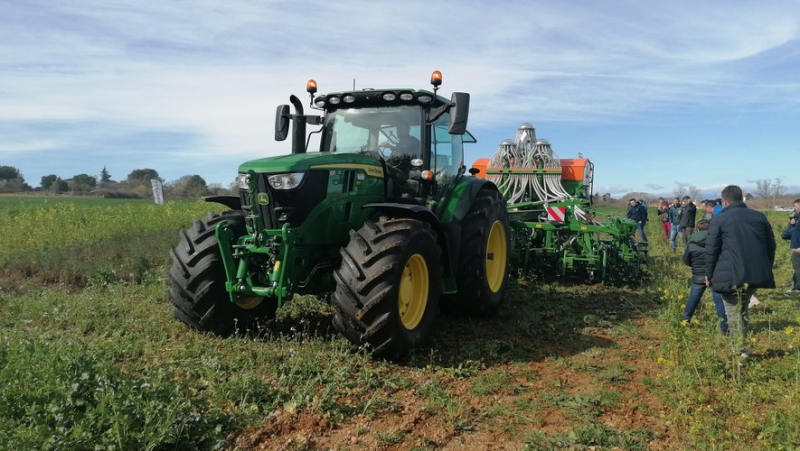
Démonstration pour coucher et déraciner le couvert végétal et réensemencer ensuite. Diane Petitmangin
La Chambre d'agriculture de l'Hérault a présenté aux agriculteurs une plateforme expérimentale de couverts végétaux, mardi 20 février, à Saint-Jean-de-Libron, à Béziers. Objectif : augmenter la fertilité des sols entre deux cultures.
Don't touch my land! The Hérault Chamber of Agriculture organized, this Tuesday, February 20, at the Cros-Viguier nurseries, in the Saint-Jean-de-Libron district, in Béziers, a morning discovery of different plant cover and specific agricultural equipment associated with these crops.
But a plant cover, quès aco ? It is one of the pillars of conservation agriculture, the objective of which is to reduce soil degradation and improve their fertility. Because the time when we plowed and turned the earth in all directions is no longer necessarily in the spirit of the times (even if the plow still has its supporters).
Soil depletion
Faced with the denaturation and impoverishment of soils, victims of many vicissitudes (erosion, atmospheric pollution, excessive use of fertilizers or pesticides, salinization, etc.), plant cover can be one of the solutions to regenerate them.
"The goal, with this trial platform, is to present to farmers different solutions for intercropping mixtures, between two plantations of wheat and sunflower, for example, relates Éric Fournaud, from Bioline France. The idea is that the ground does not remain bare during the winter.
Bringing biomass
Mixtures of plants (Alexandrian clovers and buckwheat, oats and phacelia, clovers and mustard, etc.) which, through their specific root systems and their different plant covers, make it possible to improve the yield of plants. biological activity of the earth, its aeration, trap nitrates. "This allows us to provide biomass, organic matter. It restarts microbial activity" and prevents the invasion of "weeds" (adventitia).

Éric Fournaud, from Biolane France, reviews the advantages and disadvantages for the soil of each variety of cover. Diane Petitmangin
Technique experimented by "pioneer farmers for several decades, the challenge is to adapt it to our local conditions, with our clay soils -limestone, the increasingly variable climate and pronounced droughts", indicates Rémy Kulagowski, responsible for field crops at the Hérault Chamber of Agriculture (*).
Making crops bear fruit
"It'It's often an autumn or winter cover to take advantage of the autumn rains and prepare the soil for the cultivation of legumes such as chickpeas or cereals. It can then, depending on the variety chosen, be collected to serve as fodder or be returned to the ground so that it benefits the following crop. A super compost and a luxury mulch, in a way.
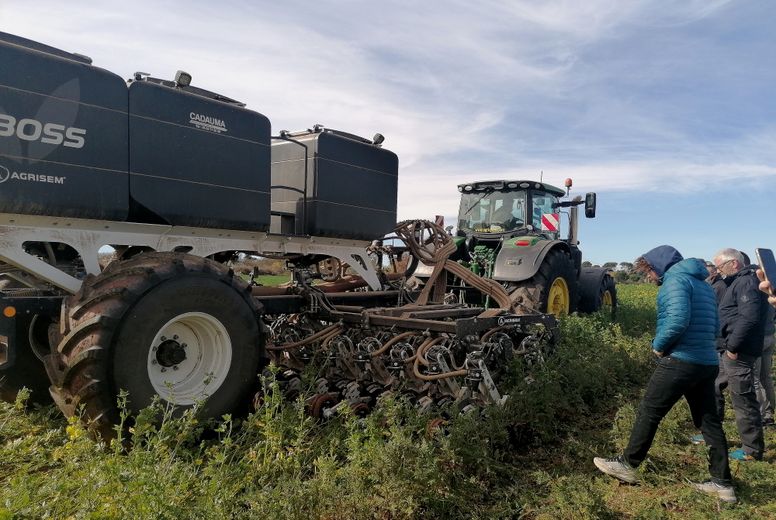
Demonstration for laying down the plant cover and making furrows in direct sowing. Diane Petitmangin
The method obviously has a cost for the farmer. Not only does he need to invest in seeds but also in the appropriate equipment to flatten, uproot the cover and reseed. Without forgetting irrigation, when autumn plays Indian summer.
The irrigation in question
But for Rémy Kulagowski, who is based "on various studies", the method "also allows you to gain useful water reserves, which can limit subsequent irrigation costs. And this mulch, which improves biomass, also acts as a buffer for water and soil temperature. this allows the earth to gain resilience in the face of heat and climatic hazards".
Words of farmers
Jean de Grave, cereal seed farmer in the Hérault plain, near Pézenas, adopted the practice plant cover on its 55 hectares, "it improves the soil. Until now, I planted fava beans (legumes, Editor's note) but that brings diseases . So, I'm going to opt for a mustard-phacelia mixture".
The problem is the cost, at 600 € per ton. "I have just crushed them and then replanted them in the ground before growing cereal seeds in the spring. You have to plant, uproot and grind, it costs time and money. And I can't do direct sowing because I don't have enough surface area (80 ha). Growing cereal seeds is special, you have to take care of the land".
Bérenger Carrier, a farmer between Saint-Thibéry and Florensac, has observed the advantages of plant cover for several years. "With land planted with corn and sunflowers, we were faced with a problem of erosion and soil leaching. We therefore tested the cutlery on part of the farm 8 years ago and on the entire farm for 3 years.
According to the young farmer, the advantages are there: "It allows us to store nitrogen and carbon and fight against weeds. And for the monoculture farmer, it breaks the cycle and decompacts the soil. Now, it remains a culture in its own right, it will take a few years to get real feedback.
But if there is "a real interest at the agronomic and ecological level", on the other hand, the return on investment is not there. "I made the decision to store them and export them for methanization but the procedures are complex. A financial boost would be needed to implement solutions at the level of agricultural cooperatives, for example.
Cros-Viguier nurseries
It is with interest that Sébastien and Pierre Viguier, the two brothers of the nurseries Cros-Viguier have put a plot of their land, à Saint-Jean-de-Libron, à available to the Chamber of Agriculture of H'Hérault to experiment with different mixtures of plant cover.
Specialists in fruit trees (multiplication and varietal research) for more than 70 years (this is the 3rd generation), previously based in Hérépian, these arborists were é confronted é a land that no longer gave anything.
"We want to see if, by mycorrhizing the soil, we can reduce the delays. Because from the seed or the nucleus to the exploitation, it takes seven years", indicates Sébastien Viguier who noted' as fruit trees planted outside. following a crop of alfalfa, had been planted with much more productive.




